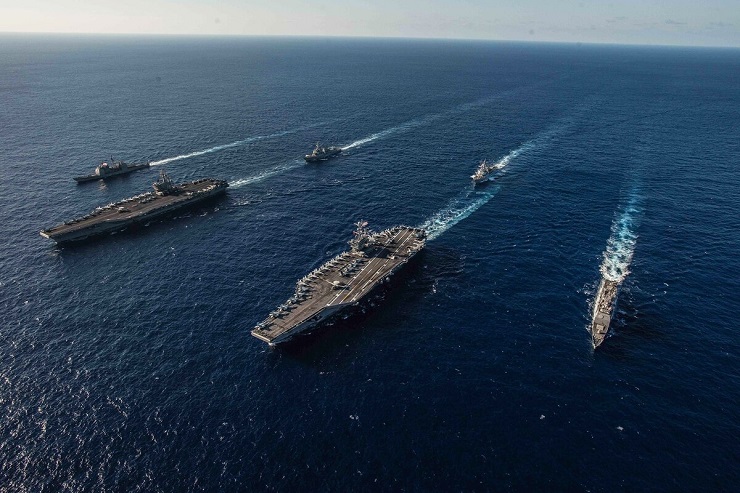The US-China standoff in South-East Asia threatens to turn into a more dangerous, on the brink of an open war, confrontation: The US has announced that it intends to deploy “high-precision missiles with enhanced survivability” along China’s eastern maritime border. This project, prepared by the US Indo-Pacific Command, provides for the deployment in the coming years of short- and medium-range land-based high-precision missiles without nuclear warheads on Taiwan, the Philippines and the Japanese island of Okinawa.
Pentagon officials explain the need for this step by saying that “without a thorough and credible conventional deterrent, China will have the courage to take action in the region and on the international stage to supplant US interests”. In order to prevent this, the US military, in addition to high-precision missiles, is going to deploy the so-called second echelon of deterrence — install air defense systems in the western Pacific Ocean — on islands stretching from southeastern Japan to Guam and Indonesia. The US military is also planning a radical change in the way it deploys troops, moving toward a strategy of dispersal in active cooperation with allies and partners. This would allow the US military presence in the Indo-Pacific region to be deployed everywhere, rather than concentrating it on a few key bases as it is now. Large forces clustered in one place are vulnerable to a preemptive missile strike in the event of an open conflict with China.
To implement all these plans, the Pentagon is asking the US Congress for additional funding, and the cost of the entire “deterrence” program is now estimated by the US military at more than $27 billion. Without this money, as Admiral Philip Davidson, commander of the US Indo-Pacific Command, said in a speech at the American Enterprise Institute, a Washington think tank, “within the next six years, China could try to change the status quo in the region”.
It is hard to doubt that US lawmakers will remain deaf to the Pentagon’s pleas, especially given the fact that Joe Biden’s first major foreign policy document, the Interim National Security Strategic Guidance, identifies China as the principal global adversary of the United States. This document states that China is “the only rival that can combine its economic, diplomatic, military and technological power to erect sustainable obstacles to a stable and open international system”. On the basis of this document, the administration of Joe Biden plans by the end of this year to prepare a new US National Security Strategy, which will replace the one that was developed under President Donald Trump in December 2017.
But already today we can say that not all of Trump’s “legacy” will be thrown into the “trash dump of history”. A key project such as the construction of the Indo-Pacific Region (IPR) with a core of four countries – the United States, Japan, Australia and India – proposed by the US administration back in 2017 to “contain the PRC,” is now experiencing a “second birth”. On March 12, 2021, the leaders of the United States, India, Japan and Australia had their first-ever video conversation. Prior to that, the so-called Quartet met regularly only at the working level and at the level of foreign ministers, and the March 12 talks were evidence that, despite the departure of President Trump from the political arena, the project he founded continues to develop. And with the same goals and in the same direction as before — strengthening military cooperation between the four countries in order to “contain China. Jake Sullivan, assistant to the US President for National Security, said this frankly at a briefing for journalists at the White House after talks between the four leaders. He noted that “the four leaders did discuss the challenge that China poses”. And they made it clear that none of them have any illusions about China”.
All of this implies that threats to China’s security will inevitably increase in the coming years, which will naturally cause Beijing to retaliate, which in turn will be forced to further strengthen its position, build new bulk islands in the South China Sea and deploy missile systems and air force and naval bases there. This will inevitably trigger a new arms race in East and Southeast Asia, and the region itself will increasingly become a potential new “hot spot” divided by the “red lines” drawn in Washington and Beijing.
In such circumstances, the plan for the integration of ASEAN countries into the Indo-Pacific space is of particular relevance. It was adopted in June 2019 at the summit in Bangkok and is aimed at expanding not military but economic ties, at the need to develop primarily economic cooperation, to form a new global free trade zone, to include in its membership states that wish to participate in it, including China. However, it is very doubtful that under current conditions, the ASEAN initiatives will be able to reverse the trend towards the formation of a military-political bloc in the IPR, directed against China. In this regard, Russia, which is also strongly opposed to the formation of a new military bloc based on the IPR, can support the efforts of ASEAN countries to reformat the IPR project from a military and anti-Chinese one to an economic and global one. This will strengthen Russia’s authority and credibility throughout the region.
Dmitry Mosyakov, Professor, Doctor of Historical Sciences, Director of the Centre for Southeast Asia, Australia and Oceania at the Institute of Oriental Studies of the Russian Academy of Sciences, exclusively for the online magazine “New Eastern Outlook”.

